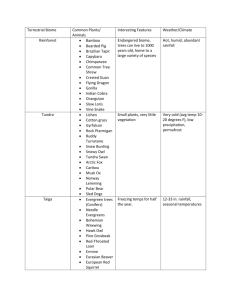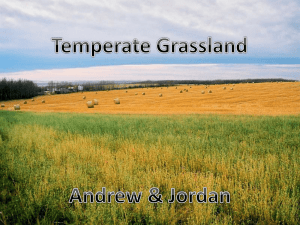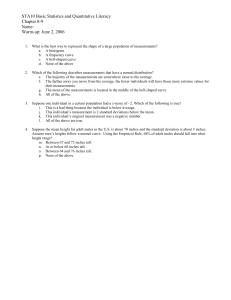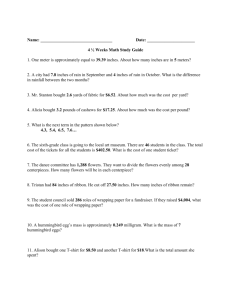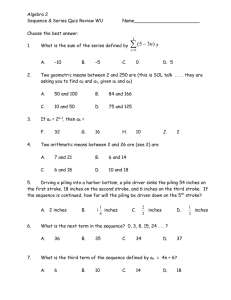Mentor Invitational – Feb
advertisement
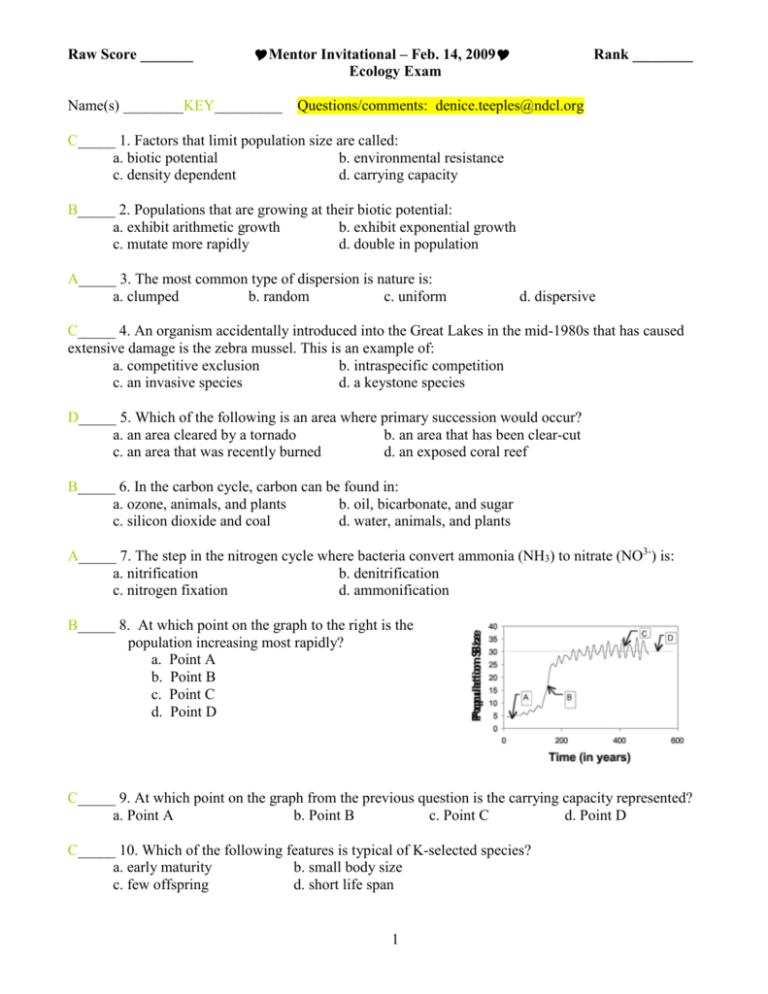
Raw Score _______ Mentor Invitational – Feb. 14, 2009 Ecology Exam Name(s) ________KEY_________ Rank ________ Questions/comments: denice.teeples@ndcl.org C_____ 1. Factors that limit population size are called: a. biotic potential b. environmental resistance c. density dependent d. carrying capacity B_____ 2. Populations that are growing at their biotic potential: a. exhibit arithmetic growth b. exhibit exponential growth c. mutate more rapidly d. double in population A_____ 3. The most common type of dispersion is nature is: a. clumped b. random c. uniform d. dispersive C_____ 4. An organism accidentally introduced into the Great Lakes in the mid-1980s that has caused extensive damage is the zebra mussel. This is an example of: a. competitive exclusion b. intraspecific competition c. an invasive species d. a keystone species D_____ 5. Which of the following is an area where primary succession would occur? a. an area cleared by a tornado b. an area that has been clear-cut c. an area that was recently burned d. an exposed coral reef B_____ 6. In the carbon cycle, carbon can be found in: a. ozone, animals, and plants b. oil, bicarbonate, and sugar c. silicon dioxide and coal d. water, animals, and plants A_____ 7. The step in the nitrogen cycle where bacteria convert ammonia (NH3) to nitrate (NO3-) is: a. nitrification b. denitrification c. nitrogen fixation d. ammonification B_____ 8. At which point on the graph to the right is the population increasing most rapidly? a. Point A b. Point B c. Point C d. Point D C_____ 9. At which point on the graph from the previous question is the carrying capacity represented? a. Point A b. Point B c. Point C d. Point D C_____ 10. Which of the following features is typical of K-selected species? a. early maturity b. small body size c. few offspring d. short life span 1 C_____ 11. All of the following are biomass fuels EXCEPT: a. wood b. alcohol c. coal d. methane C_____ 12. Which of the following are important biotic factors that can affect the structure and organization of biological communities? a. precipitation, wind b. nutrient availability, soil, pH c. predation, competition d. temperate, bacterial growth A_____ 13. Which term best describes this collection of locations: a forest, a freshwater lake, an estuary, and a prairie? a. ecosystem diversity b. Aquatic ecosystem diversity c. genetic diversity d. species diversity C_____ 14. Asia (excluding China) had a birthrate of 24 and a death rate of eight in 2004. What was the population growth rate? a. 0.16% b. 16% c. 1.6% d. 160% D_____ 15. Which of these organisms is a decomposer? a. a bacterium that makes food from inorganic compounds b. a clam that takes in water and filters food c. a plant that makes food using sunlight d. a fungus that gets nutrients form dead logs. A_____ 16. Which is an example of amensalism? a. Penicillium and bacteria b. a tapeworm and a sheep c. an orchid and a tree d. a lichen and a tree B_____ 17. Where is the largest percentage of water located? a. groundwater b. oceans c. rivers d. glaciers C_____ 18. In which area of a lake is there likely to be the greatest diversity of plankton? a. littoral zone b. profundal zone c. limnetic zone d. aphotic zone B_____ 19. According to the diagram to the right, which letter represents the zone of intolerance for the factor in question? a. A b. B c. C d. D C_____ 20. What does the letter “D” in the diagram represent? a. zone of intolerance b. zone of physiological stress c. optimum range d. upper limit C_____ 21. Two barnacle, Balanus and Chthamalus, can both survive on the lower rocks just above the low-tide line on the Scottish coast, but only Balanus actually does so, with Chthamalus adopting a higher zone. Which of the following best accounts for this niche separation? a. predation of Chthamalus by Balanus b. partitioning c. Gause’s Law d. Allee effect 2 D_____ 22. Based on the graph to the right, which term describes Location 2? a. oceanic b. polar c. temperate d. tropical A_____ 23. Suppose that in Location 2 (graph to right) there is very little rainfall during the year. What would be the name of that biome in this region? a. desert b. tundra c. temperate forest d. tropical forest B_____ 24. All of the following substances cycle through the biosphere EXCEPT: a. oxygen b. energy c. water d. carbon dioxide C_____ 25. All of the following are examples of predation EXCEPT: a. wolves killing caribou b. starfish eating clams c. leeches attaching to fish d. cats killing birds D_____ 26. Creosote bushes have adapted to desert life by: a. having enlarged stems that store water b. having a deep root system to reach to low water c. having thick spines instead of leaves to protect it from drying out in the sun d. secreting toxins into the soil to kill other nearby plants from absorbing soil moisture A_____ 27. An indicator species of the North American Prairie is: a. bison b. Przewalski’s horse c. coyote d. jack rabbit A_____ 28. In general, grasslands are: a. low in biodiversity b. high in biodiversity C_____29. Which of the following prairie animals has gone extinct? a. jack rabbit b. prairie dog c. plains wolf d. prairie mouse D_____ 30. Some forests are estimated at having 20-50 tons of topsoil per acre. How much topsoil per acre of tall grass prairie is there estimated to be? a. 10-20 tons/acre b. 60-100 tons/acre c. 150-200 tons/acre d. 200-250 tons/acre B_____ 31. The rich soil found in the central plains of the United States is due to all of the following EXCEPT: a. sediment washed from the Rocky Mountains b. sediment from the Mississippi banks c. rubble from glaciers d. windblown sand, silt and clay C_____ 32. Prairie potholes were created by: a. prairie dogs b. sand storms c. receding glaciers 3 d. farmers A_____ 33. Many deserts contain water-washed alluvium flat spaces. These poorly drained areas become alkaline through the accumulation of soluble chemicals. What type of plant is adapted to grow in this type of environment? a. halophytes b. epiphytes c. orchids d. moss B_____ 34. Deserts cover _____ percent of the world’s surface. a. 10 b. 20 c. 30 d. 40 A_____ 35. At one time, the Great Plains covered _________ of the United States. a. one fourth b. one half c. three-fourths d. almost all C_____ 36. Prairies are found on every continent EXCEPT: a. Europe b. Asia c. Antarctica d. Australia B_____ 37. __________ plays a major role in a savannas biodiversity. a. predation b. wild fires c. rainfall d. latitude D_____ 38. Savannas are different from other grasslands because: a. there are different animals in savannas b. the have more rain c. the are at lower latitudes d. they have more trees C_____ 39. Steppes differ from other temperate grasslands because: a. there are different animals in steppes b. they receive more rain and grasses are longer c. they receive less rain and grasses are shorter d. they are hotter and found in the interior of continents A_____ 40. The pampas can be found in: a. South America b. North America c. Africa d. Australia C_____ 41. If steppes received more rain they would become ___________, if they received less rain, they would become ____________. a. tropical rainforests, tundra b. temperate forests, taiga c. temperate forests, desert d. grasslands, temperate forests 4 Use the map below to answer questions 42-47. C_____ 42. Region “1” on the above map receives _________ rainfall per year. a. 15 inches b. 20-30 inches c. 30-40 inches d. 50-60 inches B_____ 43. Region “2” on the above map receives ________ rainfall per year. a. 15 inches b. 20-30 inches c. 30-40 inches d. 50-60 inches A_____ 44. Region “3” on the above map receives _________ rainfall per year. a. 15 inches b. 20-30 inches c. 30-40 inches d. 50-60 inches B_____ 45. Region “1” is better known today as the: a. wheat belt b. corn belt c. soy belt d. cattle grazing belt A_____ 46. In which region would the tallest grasses be found? a. region 1 b. region 2 c. region 3 d. all regions equally C_____ 47. In which region would an ecologist find blue gamma grass, buffalo grass, and sage brush? a. region 1 b. region 2 c. region 3 d. all regions equally B_____ 48. Some animals have aposematic coloration which means: a. the animals blend into the desert environment b. the animals exhibit a warning coloration c. the animals reflect the sun’s radiation d. the animals fur lacks pigment C_____ 49. Phreatophytes have adapted to arid climates by: a. storing water in their stems b. developing a waxy coating c. having an extensive root systems d. remaining dormant during the hottest season B_____ 50. What is the importance of aeolian processes to deserts? a. they help to form areas of water collection b. they help to form the desert basins c. they determine the climate d. they determine the distribution of fauna 5 B_____ 51. Which of the following animals would be least likely found in the desert? a. big horn sheep b. raccoon c. tortoise d. coyote 52. How do wild fires help promote the grassland ecosystem? Wild fires kill the seeds of trees and shrubs, the ash enriches the soil to promote more grass growth. How do the grasses survive the wildfires? The grasses don’t burn all the way down. They have long roots which survive and produce new plants in the enriched soil. 53. What is the benefit of an organism being crepuscular? They are active at dawn and dusk when it is cooler in the desert. 54. Owls, poorwills and nighthawks have been seen in the desert with their mouths wide open while fluttering their throat region. Why do they display this behavior? This is a behavior used to cool themselves. 55. Turkeys and Black Vultures cool themselves by urohydrosis. How does urohydrosis cool these animals? They urinate on their legs which then evaporates and cools the body. Use the pyramid of energy below to answer the following questions. Suppose that the base of the energy pyramid consists of plants that contain 450,000 Calories of food. 56. If all the plants were eaten by mice and insects, how much food energy would be available to the first level consumers? ___45,000C______________ 57. If the mice and insects were all eaten by snakes, how much food energy would be available to the snakes? ___4,500 C_______________ D C B 58. If all the snakes were eaten by a hawk, how much food energy would be available to the hawk? ____450 C__________________ A 59. How much food energy would the hawk use for its body processes and lose as heat? _____405 C (90% of 450C)________________ 60. How much food energy would be stored in the hawk’s body? ___45 C_____________ 61. Which organism in the diagram to the right is the most susceptible to the effects of biological magnification? The human. 62. Explain your answer to #61. Toxins accumulate in the tissues of organisms as you move up the food chain. 6 Use the diagram of a desert food web to answer questions 63-68. 63. What is the primary source of energy for this food web? sun 64. At what trophic level are the insects? Second trophic level 65. According to the food web, what type of consumer is the scorpion? carnivore 66. At what trophic level is the fox? Fourth order, quaternary 67. According to the food web, what type of consumer are the rodents? herbivores 68. Name all the secondary consumers. Tarantula, scorpion, lizard, snake Use the diagram below of the carbon cycle to answer questions 69-72. A B A A C D D 69. What biological process is represented by the letter “A”? Cellular respiration 70. What biological process is represented by the letter “C”? Photosynthesis 71. What process is occurring at letter “B”? Combustion of fossil fuels 72. What biological process is represented by the letter “D”? Decomposition 7 Label the following United States deserts (73-76). 73. Great Basin 74. Mojave 76. Chihuahuan 75. Sonoran 77. when two species use the same resources in different ways 78. bacteria able to make their own food from inorganic material 79. an organism which consumes meat and plant material 80. decomposer which eats detritus and dead organisms 81. two caribou fighting for a mate (type of competition) 82. the first organisms to inhabit an environment 83. the use of bacteria to clean up oil in water systems 84. the specific relationship between a remora and a shark 85. the number of individuals per unit area 86. when birth rate equals death rate 87. soil, water and air in an ecosystem 88. antagonistic behavior results in this type of population distribution 89. floods, droughts, cold temperatures are what type of limiting factors 90. an age-specific death schedule 91. the role an organisms plays in its environment 92. the relationship between algae and fungus (a lichen) 93. a group of populations living together 94. the relationship between a coyote and rabbit 95. disease is an example of this type of limiting factor 96. the physical place where an organism lives 97. the mature stage of a forest 98. the rate at which the primary producers capture and store energy 99. a species that has a disproportionate effect on its environment relative to its abundance 100. an organism which consumes only autotrophs 8 resource partitioning chemoautotroph omnivore detritivore intraspecific competition pioneer organism biological remediation commensalism population density zero population growth abiotic uniform density-independent life table niche mutualism community predation density dependent habitat climax primary productivity keystone species herbivore TIE BREAKER: The data table on the right compares the primary productivity of some of the world’s ecosystems. Use the data table to answer the following questions: Ecosystem Average Primary 1. Construct a bar graph to display the data. Productivity (g/m2/yr) Aquatic: 2. Which ecosystem is the most Coral reef 2500 productive? Use what you know to explain Estuary 1800 that fact. Lake 500 Coral reefs because they are near the top of Open Ocean 125 the photic zone. Terrestrial: Tropical rain forest 2200 3. Although the open ocean is among the Temperate forest 1250 least productive ecosystems, it contributes Tropical savanna 900 greatly to the overall productivity of the Tundra 90 biosphere. Explain this situation. The area of the open ocean is much greater than all the other ecosystems put together. 4. What are two abiotic factors that might account for the differences in productivity among the land ecosystems in the table? Latitude and precipitation both affect productivity. Drier, cooler biomes are less productive. **** Graph key features assessed: *labeled axis with units *appropriate title *appropriate increments and scale *neatness *use of graph space 9

